 September 8, 2016 John E. Ross, KD8IDJ, Editor
| |||||||||
Amateur Radio Volunteers on US East Coast Were Ready for Hermine Amateur Radio Emergency Service (ARES) and weather-spotting volunteers kept close watch on the progress of Tropical Storm Hermine as it made its way up the US Eastern Seaboard over the Labor Day weekend. The storm did most of its damage as a category 1 hurricane, after making landfall along Florida's northern Gulf Coast. Some strengthening was forecast after the center subsequently moved offshore again, after passing over Georgia, but Hermine was downgraded to a tropical storm on September 3, causing no significant weather problems. The Hurricane Watch Net (HWN), which activated to gather ground-level reports on the storm as it approached landfall, secured after 19 hours of continuous on-air coverage.
Alerted to a tropical storm watch, ARRL New York City-Long Island Section Emergency Coordinator Jim Mezey, W2KFV, asked all districts in the Section to check their equipment and their availability. Connecticut ARES went on a Level 1 alert, to "be prepared for whatever it brings," Connecticut SEC Wayne Gronlund, N1CLV, said. The National Weather Service issued its final public advisory for Hermine on September 6, when the storm -- by then referred to as a "post-tropical cyclone" -- was some 120 miles south of the eastern tip of Long Island, with maximum sustained winds of 50 MPH. Graves noted that the last major hurricane to strike the US was Hurricane Wilma in 2005. "The Hurricane Watch Net will be prepared for the next hurricane to threaten land in the Atlantic Basin," he added. Earlier this week the FMRE (Federación Mexicana de Radioexperimentadores) Emergency Communication Net activated as Hurricane Newton approached the Baja California peninsula. SpaceX Falcon 9 Failure Prompts Postponement of Fox-1Cliff and Fox-1D Integration As a consequence of the September 1 explosion of a SpaceX Falcon 9 launch vehicle during a "static fire" test, AMSAT has announced that the planned integration of Fox-1Cliff and Fox-1D on the maiden voyage of the Spaceflight SHERPA platform would be postponed. AMSAT said the impact of the incident on the launch date is unknown at this time, however. Fox-1C and Fox-1D are scheduled to launch aboard a SpaceX Falcon 9 between September 1 and November 30, and, if integration is rescheduled, they still could launch within that time frame.
Fox-1Cliff and Fox-1D carry university experiments from Pennsylvania State--Erie, Vanderbilt, University of Iowa, cameras provided by Virginia Tech, as well as Amateur Radio voice repeaters capable of U/V or L/V operation. The Nayif-1 CubeSat, developed by Emirati students from the American University of Sharjah, was expected to be put into orbit on the same launch as Fox-1Cliff and Fox-1D. Nayif-1 carries an inverting 435/145 MHz transponder (FUNcube-5) for SSB/CW. The Falcon 9 rocket destroyed on September 1 was to have put Israel's Space-Communications Ltd Amos-6 satellite into orbit on September 3, as part of an effort by Facebook to provide Internet access to parts of Sub-Saharan Africa. The cause of the explosion at Cape Canaveral remains under investigation. In a statement, SpaceX said the launch vehicle was "vertical and in the process of being fueled for the test." The company said the explosion appears to have originated in the vicinity of the upper-stage liquid oxygen tank. AMSAT has said it will provide schedule updates on Fox-1Cliff and Fox-1D, as further information becomes available.
Meanwhile, AMSAT has learned that the launch of RadFxSat-2/Fox-1E is set for December 2017. RadFxSat-2/Fox-1E is a partnership opportunity between Vanderbilt University's Institute for Space and Defense Electronics (ISDE) and AMSAT. It is similar to RadFxSat/Fox-1B, which could launch in the next several months, and both RadFxSat CubeSats will carry radiation effects experiments. The Fox-1E will feature a linear V/U (Mode J) transponder, instead of the Fox-series standard FM repeater, installed on Fox-1A through Fox-1D. The remaining Fox series CubeSats will go into space under the NASA Educational Launch of Nanosatellites (ELaNa) program. Fox-1E will be the fifth in the Fox series that AMSAT has built. Fox-1A, now AO-85, was launched in October 2015 and remains fully operational, providing science data from its onboard experiments and FM transponder service for the Amateur Radio community. -- Thanks to AMSAT News Service, Southgate Amateur Radio News More Countries Act on 60 Meter Amateur Allocations Belarus and Latvia are among the latest countries to open Amateur Radio bands at 5 MHz. The Belarus Federation of Amateur Radio and Radiosportsmen (BFRR) announced recently that radio amateurs there now have access to a new contiguous 15-kilohertz 60 meter band, consistent with the consensus reached at World Radiocommunication Conference 2015 (WRC-15). Class A licensees in Belarus may operate on 5351.5-5366.5 kHz on CW, SSB, and digital modes, on a secondary basis with a maximum output power of 50 W. In Latvia, radio amateurs also are now permitted to use 5351.5-5366.5 kHz, with a maximum power output of 15 W EIRP. (Some Latvian hams now may also operate on the new 630 meter band, 472-479 kHz, with a power of 1 W EIRP and a transmitted signal bandwidth no greater than 800 Hz.)
The South African Radio League (SARL) reports that its recommendation for a 100-kilohertz-wide 60 meter allocation, presented to telecoms regulator ICASA earlier this year, has received approval from the frequency spectrum department, although it's not yet authorized for use. The SARL proposal seeks the continued use of 5290 kHz for a WSPR propagation experiment and a secondary allocation of 100 kilohertz that includes the WRC-agreed range of 5351.5-5366.5 kHz, with a power maximum of 400 W. The SARL supported a 5350-5450 kHz allocation proposed at WRC-15 by the International Amateur Radio Union (IARU). Opposition to that proposal resulted in a compromise to allocate 5351.5-5366.5 kHz. Nonetheless, some countries, including the Netherlands, have given their radio amateurs access to the proposed 100 kilohertz. Article 4.4 of the ITU Radio Regulations âlets countries authorize frequency assignments that are contrary to the international Table of Allocations, only on a non-interference, non-protected basis. Telecomunications regulators in more than 40 countries have authorized access to 60 meters -- many, including the US, in the form of discrete channels -- on a secondary basis.
The Region 1 plan sets aside 5351.5-5354 kHz for CW and narrowband modes; 5354.0-5366 kHz for all modes, USB voice recommended, and 5366.0-5366.5 kHz for "weak-signal narrowband modes." The Region 1 plan strongly recommends that frequencies within the WRC-15 allocation only be used if there are no other frequencies available at 5 MHz under domestic (ie, ITU-R Article 4.4) authorizations. "Local nets and long rag-chew QSOs should not use the 5 MHz WRC-15 allocation but should instead make use of the 3.5 MHz, 5 MHz domestic, or 7 MHz bands, where there is more spectrum available," the plan advises. The recent St Paul Island CY9C DXpedition operated on 60 meters, activating that DXCC entity for the first time on that band. The Doctor Will See You Now! "Coaxial Connectors" is the topic of the latest episode of the "ARRL The Doctor is In" podcast. Listen...and learn!
Every 2 weeks, your host, QST Editor in Chief Steve Ford, WB8IMY, and the Doctor himself, Joel Hallas, W1ZR, will discuss a broad range of technical topics. You can also e-mail your questions to doctor@arrl.org, and the Doctor may answer them in a future podcast. Enjoy "ARRL The Doctor is In" on Apple iTunes, or by using your iPhone or iPad podcast app (just search for "ARRL The Doctor is In"). You can also listen online at Blubrry, or at Stitcher (free registration required, or browse the site as a guest) and through the free Stitcher app for iOS, Kindle, or Android devices. If you've never listened to a podcast before, download our beginner's guide. National Parks on the Air Update As National Parks on the Air (NPOTA) participants make their contacts with stations operating from the more than 480 eligible NPS units, special attention is paid to logging the 59 bona fide National Parks. In order to qualify for the National Parks Honor Roll certificate, Chasers must work 75 percent of the 59 National Park Service units activated during 2016. So far, 55 of the 59 National Parks have been visited by NPOTA Activators.
Forty NPOTA units will be on the air between September 8-14, including the Saint Paul's Church National Historic Site in New York, and San Juan Island National Historical Park in Friday Harbor, Washington. Details about these and other upcoming activations can be found on the NPOTA Activations calendar. Keep up with the latest NPOTA news on Facebook. Follow NPOTA on Twitter (@ARRL_NPOTA). Gold! NPOTA Activation Set from Alaska's Klondike Gold Rush National Historical Park Mark Bowers, VY1MAB, from Whitehorse, Yukon Territory, will activate the Klondike Gold Rush National Historical Park (HP21), for the National Parks on the Air (NPOTA) program. A storm has forced postponement of his trip until Saturday and Sunday, September 17 and 18.
The NPOTA unit has been only lightly activated this year, so it remains "a rare one." VY1MAB/KL7 will begin operation at 1700 UTC on both days, continuing for as long as he can on Saturday and wrapping up at 2100 UTC on Sunday. He will run 100 W into a Buddipole and dipole antennas. Plans call for operating SSB, PSK31, and WSJT modes. Word that gold had been discovered in the region in 1897 started the Klondike Gold Rush. Thousands of prospectors headed north hoping to cash in. The park commemorates the bravery of these so-called stampeders by protecting the trails, historic boom towns, and buildings of the Klondike Gold Rush era. ISS Expedition 48 Commander Jeff Williams, KD5TVQ, Breaks Time-on-Station Record NASA astronaut and International Space Station (ISS) Expedition 48 Commander Jeff Williams, KD5TVQ, and two of his space station crewmates returned safely to Earth this week, following Williams' US record-breaking mission aboard the ISS. Williams, Oleg Skripochka, RN3FU, and Alexey Ovchinin landed in a Soyuz TMA-20M transporter early on September 7 in Kazakhstan. Now with four space missions to his credit, Williams has logged 534 days in space, making him first on the all-time NASA astronaut list in terms of time on station. Skripochka has 331 days in space on two flights, while Ovchinin spent 172 days in space on his first mission.
"No other US astronaut has Jeff's time and experience aboard the International Space Station," Kirk Shireman, ISS Program manager at NASA's Johnson Space Center, said. "From his first flight in 2000, when the station was still under construction, to present day where the focus is science, technology development, and fostering commercialization. Jeff even helped prepare the space station for future dockings of commercial spacecraft under NASA's Commercial Crew Program." During his time on the ISS, Williams and Astronaut Kate Rubins, KG5FYJ, ventured outside the space station on two occasions, to install a docking adapter on the first spacewalk, and to retract a spare thermal control radiator and install two new high-definition cameras on the second. ISS Expedition 49 officially began with the departure of the Soyuz from the station. Expedition 49 commander Anatoly Ivanishin and his crewmates -- Rubins and Takuya Onishi, KF5LKS -- will operate the station for more than 2 weeks until the arrival of three new crew members. Shane Kimbrough, KE5HOD, Sergey Ryzhikov, and Andrey Borisenko will head to the ISS from Kazakhstan on September 23. ARRL September VHF Contest is September 10-12 The ARRL September VHF Contest gets under way on Saturday, September 10, at 1800 UTC and wraps up on Monday, September 12, at 0259 UTC. This annual event provides an opportunity for seasoned contesters and newcomers alike to experience contesting on the VHF and UHF bands. The higher you go, the greater the point value of contacts! The goal is to contact as many different stations in as many 2 Ã 1 grid squares as possible on frequencies above 50 MHz while operating from home, in the field, or as a "rover" -- traveling from grid square to grid square to hand out contacts.
Six meters has seen E skip in recent days, along with increased tropospheric enhancement. Scatter and auroral propagation are also possible. To follow potential tropo enhancement see the updated Hepburn maps. For a more focused 2 meter real-time propagation map, check out the Mountainlake APRS site. Spotting or other assistance is allowed before and during any ARRL VHF+ operating event, so participants can talk up their plans in advance and observe and discuss contacts posted on chat and spotting pages. Participants may not discuss the content of in-progress contacts, however. Newest operating categories include Single Operator 3-Band (6 meters, 2 meters, and 70 centimeters), or Single Operator FM Only. More established categories include Single Operator Portable, or Single Operator High Power/Low Power. Using just a handheld transceiver from an elevated location or attached to a small directional antenna can get you into the game. Utilizing frequencies that only require smaller, lightweight antennas provides an excellent opportunity to compete from an ideal operating location. Building your own small Yagis is fairly easy.
Rules and entry forms are on the ARRL website. All logs must be uploaded to the web app or e-mailed (or mailed) no later than 0300 UTC on October 12. Electronic logs are preferred. Send paper logs to September VHF Contest, ARRL, 225 Main St, Newington, CT 06111. For more information about the ARRL September VHF Contest, e-mail the ARRL Contest Branch. Search is On for Illegal 10 Meter GPS Buoys Radio amateurs in Portugal this summer intensified their search for GPS buoys that are illegally operating -- and intruding -- on 10 meters. A recent International Amateur Radio Union Region 1 Monitoring System (IARUMS-R1) report indicated that one such buoy was operating 24/7 on 28.100 MHz, using F1B mode (RTTY), 51 baud, 270 Hz shift. IARUMS-R1 also has posted a lengthy and growing list of intruding driftnet fisheries buoys, transmitting CW in various parts of 10 meters. A group of Portuguese radio amateurs has volunteered to identify the location of GPS buoy clusters that have been transmitting "for years" on 10 meters, an exclusive Amateur Radio allocation.
"So far, we have had some success in determining the location of the few that we can receive when propagation allows," said Paulo Teixeira, CT2IWW, the team spokesperson. "The data suggest that these clusters are located in the Atlantic, along the coasts of Africa and Europe, but it's possible that they are present elsewhere." The F1B transmissions consist of 3-second RTTY bursts. Individual transmissions are 10 seconds apart, and the cycle repeats every 5 minutes. Frequencies are between 28.000 and 28.120 MHz, at 5 kHz intervals. "So far we detected them on 28010, 28025, 28035, 28050, 28065, 28075, and 28101 kHz," Teixeira said, "but we believe that other frequency ranges are possible." The group has asked radio amateurs living along the Atlantic coast, to look for these transmissions and record them. Teixeira said poor propagation is making it difficult to obtain additional samples. "More recordings are needed in order to get greater consistency of the decoded data and, possibly, work on an automated or semi-automated decoding solution," he said. He stressed the importance of indicating date, time (UTC), frequency, and mode. Recordings should be at least 10 to 20 minutes long. E-mail results to CT2IWW via his QRZ.com address. Illegal buoys of all types -- fisheries, driftnet, GPS, and Datawell "Waverider" wave measurement buoys -- remain very active on 10 meters, according to Wolf Hadel, DK2OM, the IARUMS-R1 coordinator. The July IARUMS newsletter included more than three dozen reports. "Frequency Crunch" is ARRL/TAPR Digital Communications Conference Sunday Seminar Topic "Spectrum (It's the frequency crunch for real)" will be the Sunday Seminar topic at the ARRL/TAPR Digital Communications Conference (DCC) September 16-18 in St Petersburg, Florida. Michelle Thompson, W5NYV, and Bob McGwier, N4HY, will headline the tutorial.
"The Amateur Radio spectrum above 450 MHz is facing serious threats. The demand for useful spectrum is large and growing," a presentation abstract asserts. "We will explain why this spectrum is in demand and what you need to know and do in order to defend it." The presentation will offer a practical understanding of digital communication, software-defined radio, codecs, protocols, and
cognitive radio. Thompson heads the AMSAT Ground Terminal Team, a component of the so-called "five and dime (5 GHz and 10 GHz)" Phase 4B geosynchronous satellite project. McGwier, an AMSAT stalwart, is chief scientist at the Hume Center for National Security and Technology at Virginia Tech. The Saturday night banquet speaker will be ARRL Chief Technology Officer Brennan Price, N4QX. His topic will be "New Frontiers in Wireless: Challenges to and Opportunities for Amateur Radio." NASA's CubeSat Launch Initiative Opens Space to Educators, Nonprofits NASA is soliciting another round of CubeSat Launch Initiative (CSLI) applications. The agency is inviting accredited education institutions, nonprofit organizations, and NASA centers to join the adventure and challenge of space while helping it to achieve its exploration goals. Many research CubeSats launched as part of the CSLI have carried Amateur Radio payloads. Applications are due by November 22.
Selected experiments are considered auxiliary payloads on NASA launches or for International Space Station deployment starting next year and continuing through 2020. Selected organizations are responsible for funding the development of their CubeSats. To date, NASA has chosen 119 CubeSat missions, and 46 of those have gone on to launch; another 29 are set to launch within the next 12 months. For this round of the initiative, NASA is particularly interested in participation from organizations in the District of Columbia, Puerto Rico, and 18 states not previously selected. These include Arkansas, Delaware, Georgia, Iowa, Kansas, Maine, Minnesota, Mississippi, Nebraska, Nevada, New Hampshire, North Carolina, Oklahoma, Oregon, South Carolina, South Dakota, Washington, and Wyoming. The NASA website offers more information on the CSLI. -- Thanks to NASA The K7RA Solar Update Tad Cook, K7RA, Seattle, reports: Average daily sunspot numbers were down compared to the previous reporting week. This week, September 1-7, solar flux increased, and geomagnetic indices were quite active. The average daily sunspot number declined from 60.1 to 46.4, while the average solar flux went from 87.9 to 95.1. The average planetary A index increased from 8 to 26.6, while the average mid-latitude A index rose from 6.9 to 18.1.
Predicted solar flux is 92 on September 8-9; 90 on September 10-12; 85 on September 13-14; 83 on September 15; 108 on September 16-19; 110, 105, and 110 on September 20-22; 112 on September 23-24; 108 on September 25; 105 on September 26-27; 100 on September 28; 95 on September 29-October 1; 98 on October 2-4; 95 on October 5-6; 90 on October 7-8; 95 on October 9; 100 on October 10-11; 105 on October 12, and 108 on October 13-16. After October 16, flux values meander from 105 to 112. On September 5, predicted solar flux values for September 13-October 21 got a big boost -- a predicted increase ranging from 18 to 30 points from the September 4 prediction. Predicted planetary A index is 8 on September 8, 5 on September 9-10; 8 on September 11-14; 5 on September 15-16; 8, 5, 15, 12, and 8 on September 17-21; 5 on September 22-25; 12, 8, 35, 38, and 40 on September 26-30; 25, 20, and 12 on October 1-3; 10 on October 4-5; 5 on October 6-9, and 10, 8, 5, 5, and 8 on October 10-14. In this week's bulletin, look for an updated prediction and some auroral observations from K2KA regarding activity observed on September 3. Sunspot numbers for September 1 through 7 were 66, 50, 46, 59, 22, 32, and 50, with a mean of 46.4. The 10.7 centimeter flux was 95.2, 94.6, 99, 97.4, 93.8, 92.4, and 93, with a mean of 95.1. Estimated planetary A indices were 36, 39, 40, 28, 17, 14, and 12, with a mean of 26.6. Estimated mid-latitude A indices were 29, 24, 21, 20, 13, 12, and 8, with a mean of 18.1. This weekly Solar Update is a preview of the Propagation Bulletin issued each Friday. The latest bulletin and an archive of past propagation bulletins is on the ARRL website. Send me your reports and observations.
. . . . . . . Just Ahead in Radiosport
See the ARRL Contest Calendar for more information. For in-depth reporting on Amateur Radio contesting, subscribe to The ARRL Contest Update via your ARRL member profile e-mail preferences. Upcoming ARRL Section, State, and Division Conventions
Find conventions and hamfests in your area.
. .
Subscribe to...
Free of charge to ARRL members...
| |||||||||
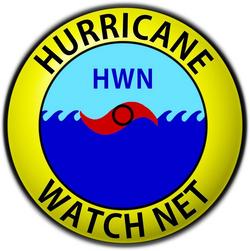 "[M]embers of the Hurricane Watch Net, operating under tough band conditions on 20 and 40 meters -- mainly caused by a geomagnetic storm -- transmitted advisories on Hermine to the affected area and received numerous weather reports -- observed and measured," said HWN Manager Bobby Graves, KB5HAV. "Those reports were then forwarded to the National Hurricane Center by way of WX4NHC." He thanked daily users of the net's frequencies --14.325 and 7.268 MHz -- for their cooperation in keeping a clear frequency.
"[M]embers of the Hurricane Watch Net, operating under tough band conditions on 20 and 40 meters -- mainly caused by a geomagnetic storm -- transmitted advisories on Hermine to the affected area and received numerous weather reports -- observed and measured," said HWN Manager Bobby Graves, KB5HAV. "Those reports were then forwarded to the National Hurricane Center by way of WX4NHC." He thanked daily users of the net's frequencies --14.325 and 7.268 MHz -- for their cooperation in keeping a clear frequency..JPG)
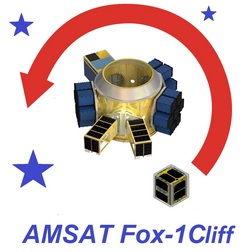
(1).jpg) Andorra returned to 60 meters earlier this summer under a new allocation of 5351.5-5366.5 kHz with a maximum power of 15 W EIRP, CW and USB, per consensus reached at WRC-15. Temporary for now, the allocation will become permanent starting in 2017. Andorra's previous 60 meter allocation was withdrawn last fall after WRC-15.
Andorra returned to 60 meters earlier this summer under a new allocation of 5351.5-5366.5 kHz with a maximum power of 15 W EIRP, CW and USB, per consensus reached at WRC-15. Temporary for now, the allocation will become permanent starting in 2017. Andorra's previous 60 meter allocation was withdrawn last fall after WRC-15. IARU Region 1 (Europe and Africa) earlier this year agreed to a paper presented by RSGB HF Manager Ian Greenshields, G4FSU, outlining a basic provisional band plan for the new 5 MHz allocation agreed upon at WRC-15. IARU Region 1 is hoping that its proposed 5351.5-5366.5 kHz usage plan will eventually be adopted by all three IARU regions.
IARU Region 1 (Europe and Africa) earlier this year agreed to a paper presented by RSGB HF Manager Ian Greenshields, G4FSU, outlining a basic provisional band plan for the new 5 MHz allocation agreed upon at WRC-15. IARU Region 1 is hoping that its proposed 5351.5-5366.5 kHz usage plan will eventually be adopted by all three IARU regions..jpg) Sponsored by
Sponsored by 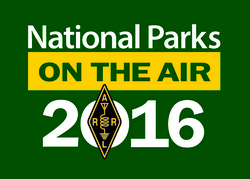 One of the four National Parks not yet activated is the National Park of American Samoa. Located near the capital city of Pago Pago, this National Park is closer to New Zealand than it is to the US, and it only receives around 5000 visitors annually. Are there any intrepid NPOTA activators willing to put this unit on the air before December 31?
One of the four National Parks not yet activated is the National Park of American Samoa. Located near the capital city of Pago Pago, this National Park is closer to New Zealand than it is to the US, and it only receives around 5000 visitors annually. Are there any intrepid NPOTA activators willing to put this unit on the air before December 31?
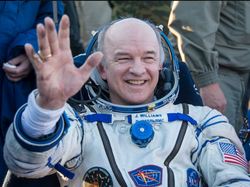
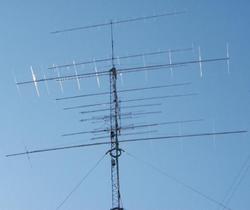
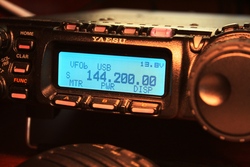 SSB/CW or digital operators will find most activity at the bottom few hundred kilohertz of the VHF+ bands. On 6 meters, most CW is found between 50.080 and 50.100 MHz, SSB between 50.125 and 50.250 MHz, and digital modes from 50.250 to 50.300 MHz. The frequencies between 50.100 MHz and 50.125 MHz are considered a "DX window," so avoid US-to-US contacts in that part of the band. On 2 meters, look for FM stations in the 146.40 to 146.57 MHz region (all FM simplex calling frequency restrictions were removed in 2015), or look for SSB around 144.200 MHz, with CW intermixed. Digital stations congregate around 144.140 MHz. On the higher bands, activity will focus around the "weak-signal" or FM calling frequencies. Check
SSB/CW or digital operators will find most activity at the bottom few hundred kilohertz of the VHF+ bands. On 6 meters, most CW is found between 50.080 and 50.100 MHz, SSB between 50.125 and 50.250 MHz, and digital modes from 50.250 to 50.300 MHz. The frequencies between 50.100 MHz and 50.125 MHz are considered a "DX window," so avoid US-to-US contacts in that part of the band. On 2 meters, look for FM stations in the 146.40 to 146.57 MHz region (all FM simplex calling frequency restrictions were removed in 2015), or look for SSB around 144.200 MHz, with CW intermixed. Digital stations congregate around 144.140 MHz. On the higher bands, activity will focus around the "weak-signal" or FM calling frequencies. Check 
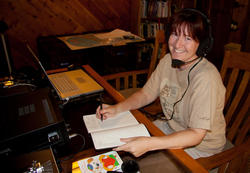

 The CSLI provides CubeSat developers with a low-cost pathway to space, in order to conduct research that advances NASA's strategic goals in the areas of science, exploration, technology development, education, and operations. The initiative provides students, teachers, and faculty with a chance to get hands-on flight hardware development experience, designing, building, and operating these small research satellites. NASA will announce its selections by February 17, although selection does not guarantee a launch opportunity.
The CSLI provides CubeSat developers with a low-cost pathway to space, in order to conduct research that advances NASA's strategic goals in the areas of science, exploration, technology development, education, and operations. The initiative provides students, teachers, and faculty with a chance to get hands-on flight hardware development experience, designing, building, and operating these small research satellites. NASA will announce its selections by February 17, although selection does not guarantee a launch opportunity.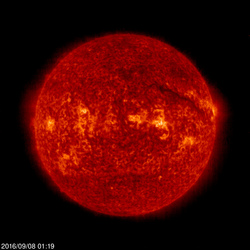 The daily planetary A index on September 1-4 was 36, 39, 40, and 28. An echo of the solar wind that caused this is expected on September 28-October 1, when the predicted planetary A index is predicted to be 35, 38, 40, and 25.
The daily planetary A index on September 1-4 was 36, 39, 40, and 28. An echo of the solar wind that caused this is expected on September 28-October 1, when the predicted planetary A index is predicted to be 35, 38, 40, and 25.








